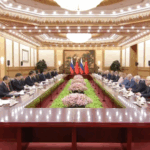Beijing Leads the Nation in Science and Technology Innovation Environment
In 2025, the comprehensive science and technology innovation level nationwide increased by 1.77 points compared to the previous year. Beijing maintained its position as having the top science and technology innovation environment in the country. The China Science and Technology Development Strategy Research Institute recently released the “China Regional Science and Technology Innovation Evaluation Report 2025.”
The report evaluates the comprehensive science and technology innovation levels of 31 provinces, autonomous regions, and municipalities across five aspects: science and technology innovation environment, science and technology innovation investment, science and technology innovation output, high-tech industries, and innovation-driven development. Data shows that China’s comprehensive science and technology innovation score reached 80.20 points in 2025, an increase of 1.77 points from the previous year. The country maintained growth momentum in science and technology innovation investment, output, and high-tech industries, effectively promoting economic and social development.
Shanghai, Beijing, Jiangsu, Guangdong, Zhejiang, and Tianjin lead the nation in comprehensive science and technology innovation levels. The radiation and leading role of innovation hubs such as science and technology innovation centers continues to strengthen, with further evident results in regional collaborative innovation development.
The report specifically mentions that collaborative innovation development in the Beijing-Tianjin-Hebei region continues to strengthen. Beijing ranks second nationally in comprehensive science and technology innovation level while maintaining the top position in innovation environment; Tianjin ranks sixth overall, with its number of scientific papers per 10,000 people, patent applications per 10,000 employees, and labor productivity all ranking third nationally; Hebei ranks nineteenth overall.
Beijing
Beijing is the capital of China, with a history spanning over 3,000 years. It served as the imperial capital for several dynasties, most notably the Ming and Qing, which left behind iconic landmarks like the Forbidden City and the Temple of Heaven. Today, it is a major global city and political center, blending ancient heritage with modern development.
Shanghai
Shanghai is a major global financial hub and the most populous city in China, located on the country’s eastern coast at the mouth of the Yangtze River. Historically a fishing and textiles town, it grew into a significant port following the 1842 Treaty of Nanking and later became an international settlement, blending Eastern and Western architectural and cultural influences. Today, it is renowned for its modern skyline, including the iconic Pudong district with landmarks like the Oriental Pearl Tower and the Shanghai Tower.
Jiangsu
Jiangsu is a coastal Chinese province in the Yangtze River Delta, historically known as a land of abundance and prosperity. It was a core cultural and economic center for many Chinese dynasties, famed for its Grand Canal cities like Suzhou and its role as a hub of silk production and scholarship. Today, it remains one of China’s most developed provinces, known for its classical gardens and historic water towns.
Guangdong
Guangdong is a coastal province in southern China with a history dating back over 2,000 years, once part of the ancient Nanyue kingdom. It became a major global trade hub through ports like Guangzhou and, more recently, Shenzhen, which was China’s first Special Economic Zone. Today, it is one of China’s most populous and economically dynamic regions, known for its Cantonese language, cuisine, and significant cultural influence.
Zhejiang
Zhejiang is a coastal province in eastern China renowned for its picturesque landscapes, historic water towns, and deep cultural heritage. It was a significant cultural and economic center during ancient times, serving as the heart of the Yue culture and the Southern Song Dynasty. Today, it is known for cities like Hangzhou, home to the UNESCO World Heritage West Lake, and as a major hub for commerce and innovation.
Tianjin
Tianjin is a major port city in northern China with a rich history as a treaty port, which opened to foreign trade in 1860. This legacy is visible in its unique European-style colonial architecture, particularly along the Hai River. Today, it is a vibrant modern metropolis and a key economic hub.
Hebei
Hebei is a northern Chinese province that surrounds the municipalities of Beijing and Tianjin. Historically, it was part of the ancient Ji Province and contains sections of the Great Wall, built during the Ming Dynasty to protect the capital from northern invasions. The province is also home to the Chengde Mountain Resort, a UNESCO World Heritage Site that served as a summer retreat for Qing dynasty emperors.
China Science and Technology Development Strategy Research Institute
The China Science and Technology Development Strategy Research Institute is a prominent national think tank established in 1982 to inform China’s science and technology policies. It conducts research on S&T development strategies, provides policy recommendations to the government, and analyzes trends in technological innovation. The institute plays a key role in shaping China’s long-term S&T planning and national innovation system.




